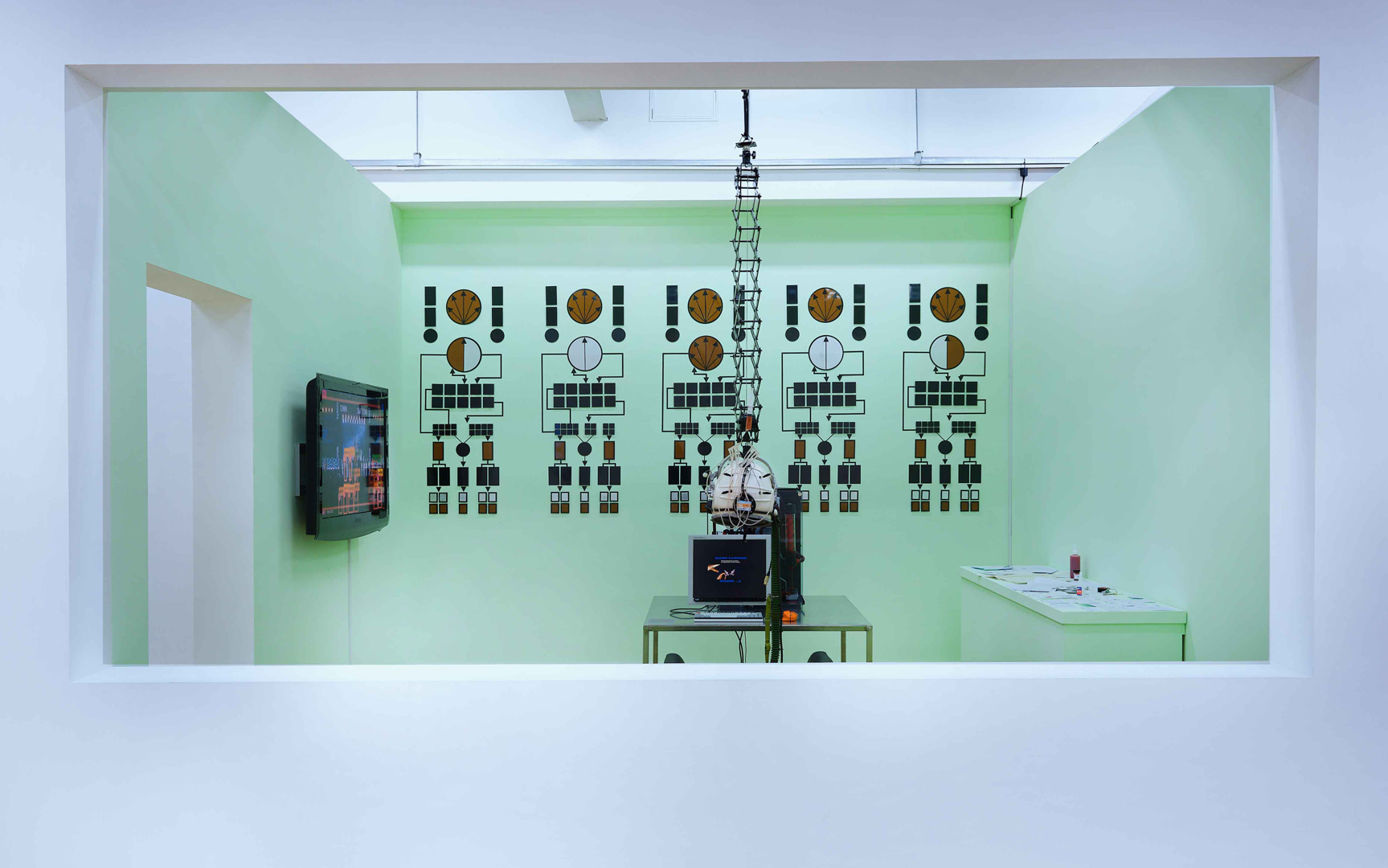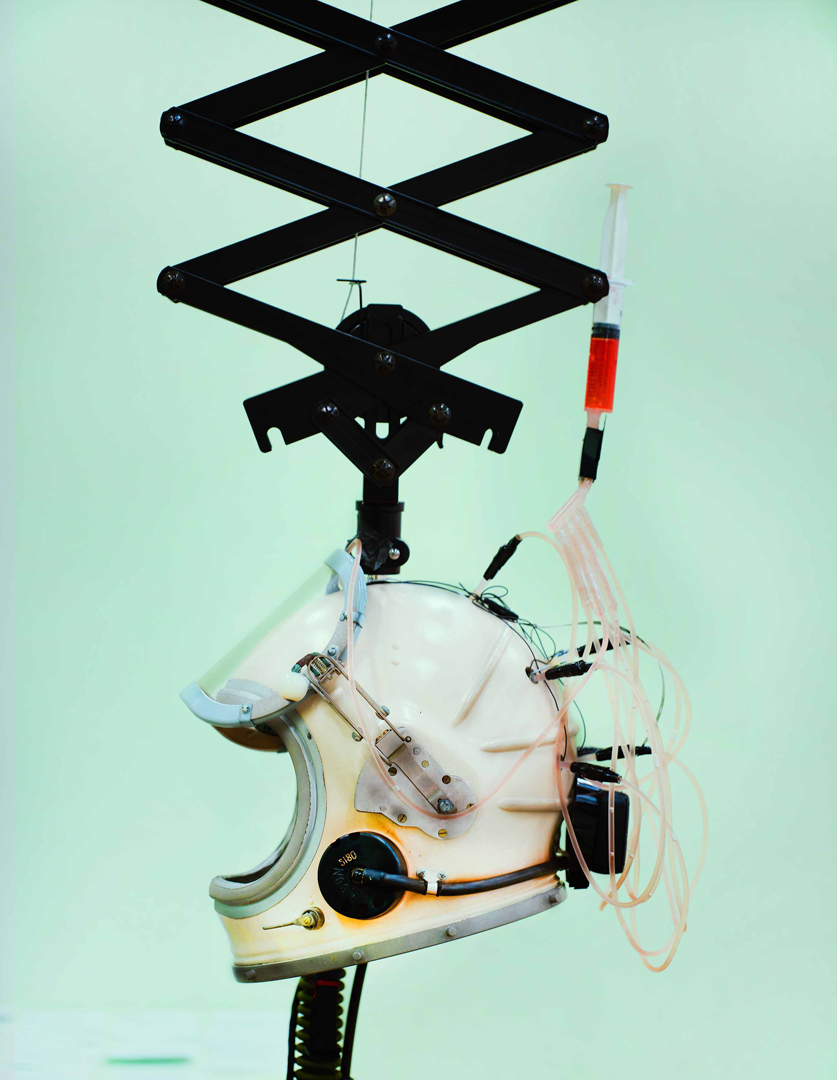Jooyoung Oh: Blind Landing, Aversion AI
Artist(s):
Title:
- Blind Landing, Aversion AI
Exhibition:
Category:
Artist Statement:
Summary
Blind Landing is composed of a helmet that tracks brain waves and eye movements, and AI software that analyzes the Youtube video frames. The work show how algorithmically promoted contents affect viewer and induce them to recover from their trusting and blind submission to the social network’s algorithms of appreciation.
Abstract
Blind Landing is composed of a helmet that tracks brain waves and eye movements, and AI software that analyzes the Youtube video frames. The work show how visual stimuli from algorithmically promoted contents affect viewer’s behavior pattern, and induce the viewer to recover from their trusting and blind submission to the social network’s algorithms of appreciation. To participate in the work, the audience is asked to put a helmet on. Then the viewer is subjected to the vision of one of the most appreciated online videos. Laterally, the screen shows the same videos analyzed by artificial intelligence software, which also colors the parts of the video that have been most seen by the viewer.
Blind Landing captures the user’s data and shows how predictable they are. Two systems were independently implemented for this purpose: 1) AI model that predicts and simulates gaze; 2) Custom built software that acquires real user data in real time and compares it withthe previous prediction model. The workutilize participants’ EEG brain signals to generate the attended scene while the YouTube appreciation. For easy wear, EEG hat was sawed inside the 70’s Pilot helmet. To allow 360 degree of freedom, hanger was installed with iron pivot on the ceiling.
The aim of the work could therefore be to induce the viewer to recover from their trusting and blind submission to the social network’s algorithms of appreciation, showing this cynical and perverse possible retaliation with wide eyes.
We live in a virtual world, where much of what our gaze falls upon in everyday life is, in fact, not real. More specifically, most of what we see is content mediated by screens: smartphones, l aptops, TVs, electronic billboards, and so on. These images are shown in real time and edited to catch viewers’ attention. To make matters worse, many internet platforms and social networking services depend upon capturing people’s attention, interest, and , ultimately, their time. Consequently, to hold future customers attention, content is shortened enough to capture the focus of bored users in an endless ‘now’. YouTube clearly demonstrates this trend with its advertisements and clips. Such designed image s can be defined as ‘explicit stimuli’. As we spend more time with these images, we replace the value of reality with screen reality. Explicit stimuli are often repeated and highlighted.
Perhaps contemporary human beings feel a sense of security when they crawl inside their screens, attracted to their own preferences, without even noticing the world the systems that attracted to their own preferences, without even noticing the world the systems that are guiding are guiding their preferences.their preferences. The work Blind Landing makes a significant contribution by proposing a method of appropriating.
The work Blind Landing makes a significant contribution by proposing a method of appropriating technology at a technology at a neural level. work present participants to reflect on how our mind prefers to be neural level. work present participants to reflect on how our mind prefers to be subjugated to communicative capitalism, submitting the mind to flooding perceptual stimuli, subjugated to communicative capitalism, submitting the mind to flooding perceptual stimuli, destroying all subjectivity.destroying all subjectivity.
Technical Information:
For the technical side, raw EEG brain signals were preprocessed with g.HIsys to remove noise, and then proper features such as gamma power were extracted. A state of the art machine learning model (e.g. convolutional neural network) was adopted as a classification model. Secondly, for the simulation of virtual viewer, Adaptive Control of Thought Rational (ACT-R) architecture, was used. The vision model was presented with five YouTube video clips as test stimuli. Then, the model was programmed to see each object in the movie with object detection(YOLO – 9000). As a result, the participant’s gaze and attentional level data was displayed alongside the AI viewer with a gradient scale consisting of five shades of red, based on the priority of prediction. In the work, five similar contents recommended by the algorithm were simulated in advance for ease of interaction. This allowed the audience to interact with the work simply by seeing the work as a video appreciation and checking how predictable his gaze was. This was to make participant realize what restrictive conditions was hidden under the convenient social network algorithm system.
Process Information:
Blind Landing is composed of technical metaphor and literature. A helmet symbolizes both history of technique and a meaning of ‘pilot tester’ which also well function as a real EEG device, sinked with eye tracker. Also, AI software that analyzes the Youtube video frames work behind the system to show exact result of the each participant’s gaze. The work implies the meaning of the work and show how algorithmically promoted contents affect viewer in realtime.
Visualizing the concept of the work and induce participant to realize that they were under the effect of 3rd party online platform was the biggest challenge. I used most viewed youtube clips to show how algorithmically promoted contents affect viewer and induce them to recover from their trusting and blind submission to the social network’s algorithms of appreciation. This was my own experience too. I started found out that youtube clips become more relevant each time I watch a video there. Then, I realized that many internet platforms and social networking services depend upon capturing people’s attention, interest, and , ultimately, their time. Consequently, to hold future customers attention, content is shortened enough to capture the focus of bored users in an endless ‘now’. YouTube clearly demonstrates this trend with its advertisements and clips.Perhaps contemporary human beings feel a sense of security when they crawl inside their screens, attracted to their own preferences, without even noticing the world the systems that attracted to their own preferences.
Other Information:
Inspiration Behind the Project
Blind Landing is an interactive installation inspired by the novel, “Night Flight”. Pilot, Fabien, trained to rely on technology rather than believe in one’s own senses in flight control. As a metaphor, the work is installed as a control room where the audience becomes an individual pilot tester, predicted and guided by an AI mass-viewer.






